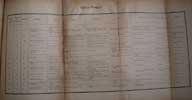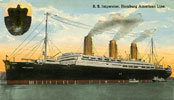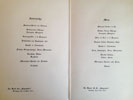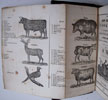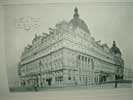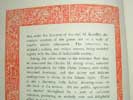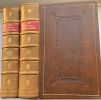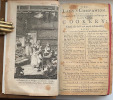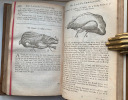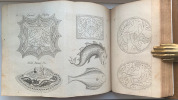The Cook's Guide and Housekeeper's & Butler's Assistant;
A PRACTICAL TREATISE ON ENGLISH AND FOREIGN COOKERY IN ALL ITS BRANCHES; CONTAINING PLAIN DIRECTIONS FOR PICKLING AND PRESERVING VEGETABLES, FRUITS, GAME, &C, The Curing of Hams and Bacon; THE ART OF CONFECTIONARY AND ICE-MAKING, AND THE ARRANGEMENT OF DESSERTS. WITH VALUABLE DIRECTIONS FOR THE PREPARATION OF PROPER DIET FOR INVALIDS; ALSO FOR A VARIETY OF WINE-CUPS; AND EPICUREAN SALADS,AMERICAN DRINKS, AND SUMMER BEVERAGES. BY CHARLES ELME FRANCATELLI. PUPIL OF THE CELEBRATED CAREME, AND MAITRE-D'HOTEL AND CHIEF COOK TO HER MAJESTY THE QUEEN. AUTHOR OF "THE MODERN COOK" WITH UPWARDS OF FORTY ILLUSTRATIONS. LONDON; RICHARD BENTLEY, NEW BURLINGTON STREET. 1861. (Right of Translation is Reserved)
FIRST EDITION. 1861. 1fep. Frontispiece with light water stains and slight foxing. Title page.[1] 1+iv-vi Preface. a2 Postscript.[1] 1+viii Illustrations. 1+x-xx Contents. 1+2-452. 1+454-484 Bills of Fare. 1+486-488 Glossary. 1+490-512 Index. p22 of very interesting Advertisements on pink paper. 1fep. Two plates of Appetisers facing pages 114 and 130 . Original bottle green cloth boards with blind tooling and a neatly relaid and slightly darkened original cloth spine with blind tooling and gilt writing. The guttering has been strengthened. With twenty nine in-text and two full page illustrations. A very nice copy in the original state.
- Despite his name and his French training, Charles Elmé Francatelli was English by nationality. He wrote several important cookbooks, and held in succession three of the most prestigious cooking positions in England at that time. Francatelli, of Italian ancestry, was born in London in 1805, but grew up in France. There, he learnt cooking, getting a diploma from the Parisian College of Cooking, and working under the great French chef Marie Antonin Carême. (Some sense of Careme's grand influence can be seen in this book from p197 where in-text illustrations, of Pates, Timbales, Chartreuses, Mazarines and Croustades etc. enhance the recipes.) Upon his return to England, he worked for various places and people of distinction; such as Rossie Priory and Chesterfield House; As 'Chef de Cuisine' for the Earl of Chesterfield; At Chislehurst in Kent for Sir Herbert Jenner-Fust; At the Coventry House Club; He also cooked for the Earl of Errol. On February 4th 1839, he started as 'Chef de Cuisine' at Crockford's Club in London, taking over from the previous chef Louis Eustache Ude, who had just quit in a salary dispute at the start of February. (Disraeli didn't think much of Francatelli's chances at following in Ude's footsteps, but time was to prove him wrong.) He didn't stay at Crockford's long, though; by 1840 or 1841, he started work for Queen Victoria as Maitre d'Hotel and 'Chief Cook in Ordinary' at Windsor, staying there for four years. In 1845, he published his book "The Modern Cook." in England and in America the following year. The book sold well on both sides of the Atlantic. In it, he advocated two courses for meals -- a savoury followed by dessert, which is still mostly the norm today. In 1850, he then became 'Chef de Cuisine' at the Reform Club, taking over from Alexis Soyer, who had resigned in May of that year. Francatelli worked there with distinction for seven years. In 1852, he got the food company Brown and Polson to be a sponsor of his very rare little book, "A Plain Cookery-Book for the Working Classes". In return, he gave Brown and Polson space for a large advertisement at the back of the book, and mentioned their products by name in several of his recipes. In 1861 he published this book, "The Cook's Guide and Housekeeper's & Butler's Assistant", which became the book of reference for any well-managed household. His last job was at the Freemasons' Tavern in London. He died on 10 August 1876 at Eastbourne, England. The Times ran an obituary for him on 19 August 1876 titled "An Illustrious Chef" (page 4 of that day's paper.) As a small footnote, it is known that a younger cousin of his, whom he never met, Laura Mabel Francatelli (c. 1880 or 1881 - 2 June 1967), survived the Titanic. She was travelling as secretary to Lady (Lucy) Duff-Gordon, a fashion designer at the time, who also used a sister of Laura, Phyllis Francatelli, as a model.

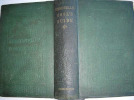




click on image to enlarge

Antiquarian category
ref number:
11028 






